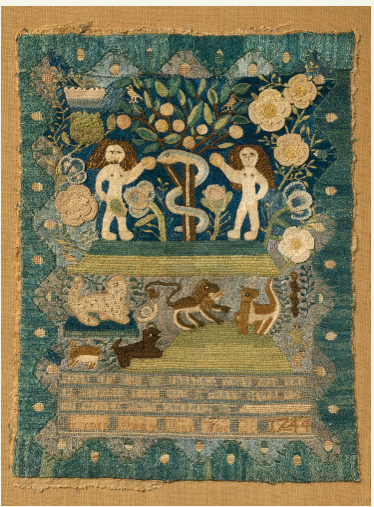This was a Boston sampler from 1744 and I believe it wasn't exhibited in Pam Parmel's landmark exhibition of Boston Colonial Embroidery at the MFA Boston in 2011. (Read an article by MFA Boston curator Pam Parmel on the exhibit here with lots of pictures). It's cousins were, and so the style was well known to me. This piece out shown them all as the silk amazingly was the same color it was when stitched as well as done so well. Graphically it is really stunning and the inclusion of the detached needlelace flowers is fantastic. Pan Parmel has theorized that these samplers were derived from 17th century samplers that may have been in the possession of the teachers at the time because they do not follow the progression of the early 18th century samplers of the English tradition.
There have been only a handful of embroidered samplers which have sold in the six figures ever. One that was also in this type of condition and worked by the daughter of the man who rowed Paul Revere across from the North Church for his ride was sold a few years ago for this level. Again, it had 'everything going for it'. This piece was estimated at $30,000-$40,000 but it went for $233,000. I would have liked to have been there to hear the buzz yesterday in the auction room. $30,000 now sounds like a bargain. But I am so happy to have seen it, especially as so many of our pieces that survive are devoid of the exuberant color that only little girls could have imagined going together. I just might have to work a piece in these dark and bright colors myself. I love the line up of the animals in the garden of eden, look to the far right and you will see a tiny frog stitched just above a small bird.
Secretly I hope that the MFA Boston was bidding and won this piece so everyone would be able to enjoy it some day, but I doubt that they had the acquisition budget for this level.
Below are the catalog notes from Sotheby's on this piece. You can go to their site and use the zoom function to enjoy the piece and its lovely stitching and color from home. Remember that this piece is only the size of a sheet of paper!
Lydia Hart worked the most visually appealing example within Boston's earliest known group of samplers which presently dates from 1724 to 1754. Nine pieces portray nearly identical figures of Adam and Eve above similar beasts, birds, and bugs. They also include elegant renditions of the Scottish thistle and Tudor rose, signifying the 1603 union of Scotland and England upon the ascension of James I (1566-1625). Lydia's work is the first to have what became a characteristic border for these and later eighteenth-century pastoral samplers, but its solidly worked background is unique. Earlier pieces by Mehetabel Done (1724), Martha Butler (1729), and Abigail Pool (1737) depict Adam and Eve beneath borderless alphabets and band patterns. In 1734 Ann Peartree and Elizabeth Langdon worked nearly identical borderless pictorial samplers with similar motifs on brown linen. More closely related to Lydia's work are samplers by Rebekah Owen (1745), Sarah Lord (1753), and Mary Lord (1754), with the same borders and gardens.2 Rebekah and Mary worked the same inscription as Lydia. Lydia's identity remains uncertain. The Lydia born in Boston to Elias and Lydia Hart on September 12, 1719, is unlikely to have worked this at the age of twenty-four.3Among the nine pieces described, the known ages of six makers range from nine to thirteen years.
A Lydia of appropriate age was born in Northington, Connecticut, to Joseph and Mary Bird Hart on August 8, 1728. Her father was a shoemaker, deacon of the church, and a town magistrate.4 Quite possibly his daughters were educated in Boston. This Lydia married Noah Gillet (1718-1790) on December 15, 1748, and their ten children were born in Farmington, Connecticut.5 No woman is known to have kept a Boston girls' school from 1724 through 1754, but circumstantial evidence suggests that these samplers may have been worked under the instruction of Susanna Hiller Condy (1686-1747) and her sister-in-law Abigail Stevens Hiller (?-1775), who advertised her school from February 1748 until May 1756.6 Four samplers dated 1765 to c. 1772 have Lydia's border and similarly worked flowers, including one by Mary Welsh, whose sister Hannah married Abigail's son Joseph (1721-1758).7 -B.R.
1 For five of the nine samplers mentioned here, another closely related example, and the best known English prototype, see Ring, Girlhood Embroidery, vol. 1, pp. 37-41, figs. 33-370 39, and the catalog for Sotheby's sale 7010 (6/97, lots 330, 331, 332).
2 This was probably the Lydia Hart who worked a borderless band sampler inscribed "Boston" and dated "February The 4 Day 1731" (collection New Hampshire Historical Society, Concord).
3 Alfred Andrews, Genealogical History of Deacon Stephen Hart and His Descendants, 1632-1875 (Hartford, Conn.: Case, Lockwood, and Brainard, 1875), pp. 169, 181.
4 Wilma Gillet Thomas, The Joseph Gillet/Gillett/Gillette Family of Connecticut, Ohio, and Kansas (Chicago, Ill.: Adams Press, 1970), p. 32.
5 Boston Evening-Post (Feb. 1, 1748, April 22, 1751, and April 9, 1753), and Boston Gazette (June 11, 1754, May 26, 1755, and May 24, 1756).
6 Stephen Huber and Carol Huber, The Sampler Engagement Calendar 1992 (Old Saybrook, Conn.: 1991), fig. 45, Calendar 1993, fig. 38, Elisabeth Donaghy Garren, "American Samplers and Needlework Pictures in the DAR Museum, Part I: 1739-1806," The Magazine Antiques 105, no. 2 (February 1974): 358, and Ring, Girlhood Embroidery, vol. 1, p. 53, fig. 51.
7 Helen Bowen, “The Fishing Lady and Boston Common,” Antiques 4, no. 2 (August 1923): 70-73.
7 Helen Bowen, “The Fishing Lady and Boston Common,” Antiques 4, no. 2 (August 1923): 70-73.




Tidak ada komentar:
Posting Komentar